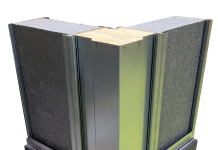Phil Brown, European regulatory marketing manager at Pilkington United Kingdom Limited, part of the NSG Group, offers his top tips for performing a thermal safety check.
Assessing the risk of thermal fracture is an essential task before installing glass, particularly solar control glass. The central area of glass exposed to solar radiation absorbs heat, rises in temperature and expands. The outer edges of the glass, however, shielded from solar radiation by the frame, remain cooler.
Thermal safety is concerned with temperature difference between the hottest and coldest parts of the glass, and the distribution of temperature across the glass. The resulting differential expansion causes tensile stress at the edge of the glass. If this exceeds the breakage strength of the glass a thermal fracture will occur.
Helpful tips for performing a thermal safety check prior to installing an insulating glass unit (IGU):
- Different parts of the world receive different amounts of solar radiation, so considering the project’s location is essential.
- Check your compass. A north-facing elevation in the UK, for example, will receive relatively little solar radiation in comparison to other orientations.
- Know your glass. Glass type and thickness will affect the solar absorption. Some products will absorb more of the sun’s energy than others. If the glass is toughened, then it would be expected to be thermally safe.
- Inside knowledge. Any blinds or curtains behind the window can influence the free movement of air over glass. The colour of the material can also play a role – a light-coloured blind will tend to reflect more back into the glass.
- Back-up plan. Commonly referred to as a back-up, this is a structural item immediately behind the glass such as a raised floor or low hanging ceiling. If the glass passes in front of a floor slab, this could reduce loss of heat from the glass and increase its temperature.
- Look from the outside. What’s happening on the outside of the building needs to be considered. External projections such as overhangs can shade part of the glazing, creating a temperature difference between the exposed and unexposed areas. Trees and nearby buildings can also partially shade the glazing.
- As well as glass type, the frame is also important, whether it is PVCu, aluminium or timber. A heavyweight frame will tend to insulate the glass edge more than a lightweight one, generating a larger temperature differential between the edge and centre of the glass.
- Size is everything. As for mechanical strength, the probability of finding a critical flaw is higher for larger panes.
- Keep an open mind. Is the window fixed or can it be opened? If it is openable, then it may receive more of the sun’s radiation when ajar.
- Although the sun is the primary source of thermal stressing in glass, any heaters or radiators blowing warm air in the direction of the glass can act as secondary sources.
For more advice on glass thermal safety, please view the Pilkington webpage: http://pilkington.co.uk/glass+thermalstress











